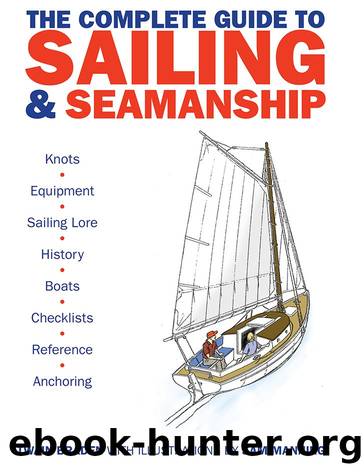The Complete Guide to Sailing & Seamanship by Twain Braden

Author:Twain Braden
Language: eng
Format: epub
Published: 2013-05-22T00:00:00+00:00
CHART
According to the National Geospatial-Intelligence Agency (NGA), the federal agency that disseminates charts in the United States, "A Nautical Chart is a graphic portrayal of the marine environment showing the nature and form of the coast, the general configuration of the sea bottom including water depths, locations of dangers to navigation, locations and characteristics of man-made aids to navigation, and other features useful to the mariner."
I went to a Waldorf school, which means I have an insatiable predilection for taking a given subject, in this case cartography, and finding ways to make it more colorful and interactive than the NGA's definition. Waldorf students are urged to tell and listen to stories and draw pictures of every subject, shading them in with color. In chemistry we drew the elements in their natural state; in biology we drew mitosis and miosis, carefully shading each cell with different colors; in geometry we drew pentagons and dodecahedrons, all their parts colored and shaded like the patterns of a quilt. In English and art history we illustrated the myths and legends with knights and dragons, scenes of romance and adventure. It was a picaresque education, but it can also be an obsessive habitâseeing nothing as complete unless it has been illustrated and shadedâand is a habit that, even into adulthood, we find tough to shake.
In my navigational practices, this has meant that I've always drawn on my charts, annotated arrivals and departures, and made drawings of occurrences with notes on dates and the company I was keeping. This was in part inspired by stories I'd heard of this practice by shipmasters during the Age of Exploration, who often created their own charts of their sea routes and kept them carefully guarded as trade secrets. A favorable anchorage, for example, gave them a competitive edge over other masters, as did knowledge of local wind and current patterns or lucrative fishing grounds. All this information was annotated and illustrated on charts.
I was recently at a school reunion, in which I got to talking with a former classmate about a recent trip to Bermuda, in which he served as the boat's navigator. He, too, admitted to having felt his Waldorf education surging from his fingertips during the voyage, almost unwillingly, as he plotted progress on the charts. "I shaded everything with colored pencils," he told me. "The currents in one color, the winds another; the land masses a different color. When the others in the crew saw what I had done, they said, 'Holy shit!'" A piece of navigational notation had become a kind of impromptu art exhibit.
Whether you have these inclinations or not, illustrating and annotating your home waters charts is exceedingly helpful for your future visits to various anchorages. And it makes a fascinating illustrated history of your sailing adventures that might, someday, become worthy of hanging on your wall.
Let's start with the earth's imaginary grid system, latitude and longitude. On a Mercator-projection chart (the most common projection for navigational charts), all lines of both latitude and longitude are presented as parallel.
Download
This site does not store any files on its server. We only index and link to content provided by other sites. Please contact the content providers to delete copyright contents if any and email us, we'll remove relevant links or contents immediately.
Small Unmanned Fixed-wing Aircraft Design by Andrew J. Keane Andras Sobester James P. Scanlan & András Sóbester & James P. Scanlan(32682)
Navigation and Map Reading by K Andrew(4960)
Endurance: Shackleton's Incredible Voyage by Alfred Lansing(4625)
And the Band Played On by Randy Shilts(2078)
Wild Ride by Adam Lashinsky(1898)
The Box by Marc Levinson(1894)
Top 10 Prague (EYEWITNESS TOP 10 TRAVEL GUIDES) by DK(1892)
The Race for Hitler's X-Planes: Britain's 1945 Mission to Capture Secret Luftwaffe Technology by John Christopher(1764)
The One Percenter Encyclopedia by Bill Hayes(1752)
Trans-Siberian Railway by Lonely Planet(1663)
Girls Auto Clinic Glove Box Guide by Patrice Banks(1653)
Looking for a Ship by John McPhee(1606)
Batavia's Graveyard by Mike Dash(1581)
TWA 800 by Jack Cashill(1562)
Fighting Hitler's Jets: The Extraordinary Story of the American Airmen Who Beat the Luftwaffe and Defeated Nazi Germany by Robert F. Dorr(1543)
Good with Words by Patrick Barry(1538)
Troubleshooting and Repair of Diesel Engines by Paul Dempsey(1528)
Ticket to Ride by Tom Chesshyre(1520)
Bligh by Rob Mundle(1516)
